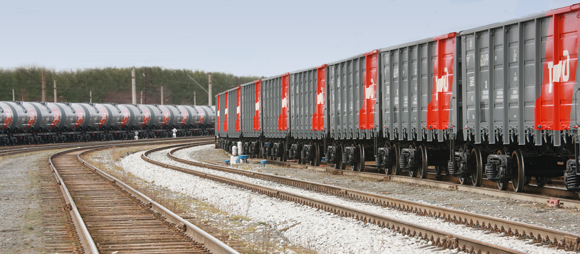Service functions
-
Download center
-
Add to My Report
-
My Report (0)
-
Print this Page
-
Download in PDF
-
Share
-
Feedback
-
Interactive analysis
-
Browsing history
-
Offline version
-
Company in soc.networks
-
Compared to 2011
-
Popular pages
-
Company on the map
-
Compact view
| Enter e-mail recipient * | Your e-mail * | Comment : | |
| * required fields | |||
Freight Transportation Market Review

In 2012, rail transport freight turnover in Russia increased 2.9%, reaching 2,782.6 bln tr-km. Growth gradually slowed down over the year: from +12% in January 2012 to a decrease of 2.5% in December 2012, as a result of a slow down in industrial output growth and a curtailment of capital investment. Both macroeconomic indicators strongly affect the volume of freight railway transportation.
* Rail transport share (excluding pipeline transport)
JSC “RZD” increased its level of transportation against volumetric indicators. Against a national industrial output growth of 2.6% in 2012, loading increased 2.4%, reaching some 1,271.9 mln tons.
The main driver of loading growth has recently been due to exports via Russian ports with domestic transportation trends falling dramatically lower than even before the pre-crisis level. Consequently, in certain regions of export transportation, the railway network operated at full capacity, while in the Far East, network loading beat the highest figure ever recorded in the entire history of Russian railways by 30%.
Against this relatively significant increase in its transportation performance against volumetric indicators in 2012, JSC “RZD” ‘s contribution to GDP was slightly lower – 1.71% versus 1.77% in 2011 – a clear indication of the influence on the economy of a dramatic decline in transportation, the creation of conditions to develop other industries at the expense of railway price increases and, an underfunding of investment in the railway infrastructure.
 Address of the President
Address of the President
 175th Anniversary of Russian Railways
175th Anniversary of Russian Railways
 Analysis
Analysis
 Save Key Indicators to XLS
Save Key Indicators to XLS
 Transport Development Strategy
Transport Development Strategy
 Investment Activity
Investment Activity
 Download Chapter Financial and Economic Performance
Download Chapter Financial and Economic Performance
 Rating
Rating
 Loan Portfolio
Loan Portfolio
 Management System
Management System
 Governing Structure Of JSC Russian Railways
Governing Structure Of JSC Russian Railways
 Personnel management
Personnel management
 Housing policy
Housing policy